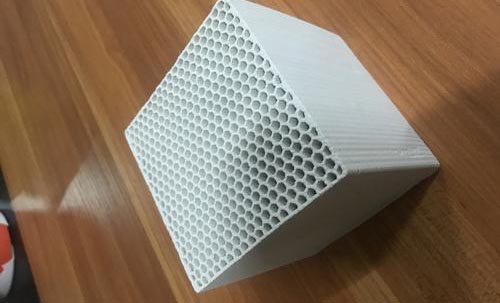
Honeycomb zeolite molecular sieve Application and principle of
① Natural zeolite is mostly formed by reaction of volcanic tuff and tuffaceous sedimentary rock in marine or lacustrine environment. More than 1000 kinds of zeolite minerals have been found, 35 of which are more important. Clinoptilolite, mordenite, mordenite and rhombolite are common. It is mainly distributed in the United States, Japan, France and other countries. China has also found a large number of mordenite and clinoptilolite deposits. Japan is a country with a large amount of natural zeolite mining.
② Because natural zeolite is limited by resources, synthetic zeolite has been widely used since 1950s.
Honeycomb zeolite molecular sieve The prefixes are commonly used to classify molecular sieves with different crystal structures, such as 3a, 4a and 5a molecular sieves. Type 4a refers to type a in the table, with an aperture of 4 ∨;. Type a molecular sieve containing na+is recorded as na-a, if na+is replaced by k+, the pore size is about 3 ∨;, That is 3a molecular sieve; For example, more than 1/3 of na+in na-a is replaced by ca2+, and the pore size is about 5 ∨;, It is 5a molecular sieve.
Use of molecular sieve:
1. 3a Molecular sieve application: drying of various liquids (such as ethanol); Drying of air; Drying of refrigerant; Drying of natural gas and methane; Drying of unsaturated hydrocarbon, pyrolysis gas, ethylene, acetylene, propylene and butadiene.
2. 4a Molecular sieve uses: deep drying of air, natural gas, alkanes, refrigerants and other gases and liquids; Preparation and purification of argon; Static drying of drug packaging, electronic components and perishable substances; Used as dehydrating agent in paint, fuel and coating.
3. 5a molecular sieve uses: pressure swing adsorption; Air purification dehydration and carbon dioxide.
4. Use of 13x molecular sieve: gas purification in air separation unit, removing water and carbon dioxide; Drying and desulfurization of natural gas, liquefied petroleum gas and liquid hydrocarbon; Generally, the gas is deeply dried.
Principle of molecular sieve:
1. Adsorption function: the adsorption of substances by molecular sieves comes from physical adsorption (van der Waals force). Its crystal cavities have strong polarity and coulomb field, and show strong adsorption capacity for polar molecules (such as water) and unsaturated molecules.
2. Screening function: the pore size distribution of molecular sieve is very uniform, and only substances with molecular diameter smaller than the pore diameter can enter the crystal cavity of molecular sieve.
3. Molecules of different substances can be distinguished by adsorption priority and size, so it is called "molecular sieve" vividly.
